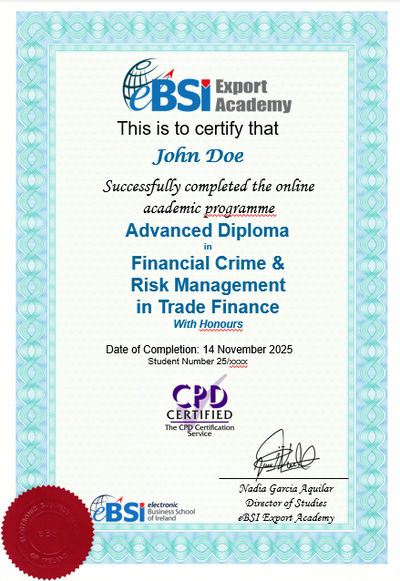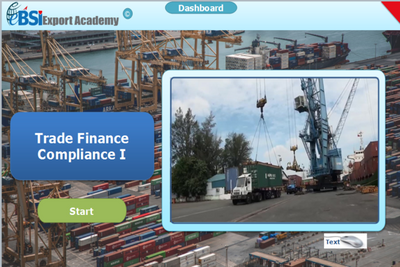THE ISSUE OF DISCREPANCIES AND THE ROLE OF THE DOCUMENTARY CREDIT
 If you ask a banker, an exporter, an international cargo insurance specialist, a carrier or a freight forwarder, what the biggest problem is when dealing with documentary credits, you will most likely hear them all saying in unison: ‘discrepancies.
If you ask a banker, an exporter, an international cargo insurance specialist, a carrier or a freight forwarder, what the biggest problem is when dealing with documentary credits, you will most likely hear them all saying in unison: ‘discrepancies.
Yes, we all seem to acknowledge that the high number of discrepant presentations under documentary credits is a serious problem. It leads to delays, increase of the cost, and it can even result in refusal of payment. The beneficiary then feels that he does not really ‘benefit’ so much from using the instrument and his frustration spreads around the whole industry.
However, is it a problem of the documentary credit as such? Or is rather the one of the exporter himself who is not able to present compliant documents?
As a frequent international lecturer and consultant, I am convinced that to the significant extent exporters themselves are to blame as well. Many of them do not pay enough attention to the terms and conditions of the contract of sale which includes the payment condition, i.e. the payment by means of the documentary credit. When the credit is advised to them, they rarely read it carefully and insist on changing incorrect or vague conditions. And finally, they do not make sure that the documents comply with the credit terms and conditions in time of their presentation.
No doubt, we bankers must also honestly admit that there is some blame on us. We seem, from time to time, disagree among ourselves whether a document is discrepant or not. Partly it is caused by the lack of education and understanding.
Secondly, many problems and issues regarding presentation of documents could be easily avoided by investing appropriate time and energy when issuing the credits! Many credits include conditions which are vague, inappropriate and sometimes even clearly unworkable! Has the bank merely copied instructions from the applicant without discussing them? Or even it added its own inappropriate conditions?
The buyer of the goods, the applicant, is the party which gives the issuing bank instructions regarding the terms and conditions of the credit. Does he strictly follow the relevant terms and conditions of the underlying contract of sale? Or does he rather develop new terms and conditions without having them discussed and agreed upon with the seller, the beneficiary, at the first place?
The applicant might have, unless he makes his homework properly, another “problem” related to the documentary credit. The payment under the credit at this account would be done even when the imported goods do not satisfy underlying terms and conditions of the contract of sale provided they comply with the credit terms and conditions. Therefore, the applicant should well think ahead whom he makes business with, and also very carefully about which documents, with what content, are to be presented by the beneficiary!
Role of the documentary credit
Article 4 of UCP 600, ICC Rules for documentary credits, says: “A credit by its nature is a separate transaction from the sale or other contract on which it may be based.
Banks are in no way concerned with or bound by such contract, even if any reference whatsoever to it is included in the credit.“
Article 5 then adds: “Banks deal with documents and not with goods, services or performance to which the documents may relate.“
These two rules sharp main characteristics of the documentary credit. They are to be well understood by all parties, not only theoretically, but practically.
The parties using the credit must take appropriate measures to achieve the success when using the unique documentary credit concept, i.e. payment obligation of the bank – the independent third party paymaster, to pay against complying documents.
 The beneficiary knows that he is to be paid by the bank if the presentation of documents complies even if there is a dispute related to the delivery of the goods with the applicant. The credit thus provides him with “the money first”, and possibly “argue with the applicant later” concept. However, it might also happen that the goods comply with the underlying contract, but the related documents presented under the credit do not comply with its terms and conditions, and then the payment might be well refused by the bank. In such a case, which the beneficiary should try to avoid as much as possible, he would have to “argue first” with the applicant, but certainly outside the credit itself.This concept brings a lot of advantages for the parties concerned (but not to all at the same level), but also disadvantages, or better to say: “challenges”.
The beneficiary knows that he is to be paid by the bank if the presentation of documents complies even if there is a dispute related to the delivery of the goods with the applicant. The credit thus provides him with “the money first”, and possibly “argue with the applicant later” concept. However, it might also happen that the goods comply with the underlying contract, but the related documents presented under the credit do not comply with its terms and conditions, and then the payment might be well refused by the bank. In such a case, which the beneficiary should try to avoid as much as possible, he would have to “argue first” with the applicant, but certainly outside the credit itself.This concept brings a lot of advantages for the parties concerned (but not to all at the same level), but also disadvantages, or better to say: “challenges”.
The independence principle of the credit must be fully understood by the applicant and banks concerned as well. Banks are indeed in the credit transaction independent, neutral, both from the applicant and the beneficiary, when it comes to the decision whether the documents comply or not, i.e. whether the payment is to be done or not.
Therefore, the documentary credit poses a lot of challenges to the parties concerned, above all to the beneficiary and the applicant. It is up to them to negotiate the appropriate terms and conditions of the credit and incorporate them in the relevant contract of sale. The documents requested by the credit should, as much as possible and suitable, correspond to the obligations of the seller in relation to the delivery and possibly other obligations he has under the contract of sale.
It is all about documents. Parties need to know the relevant aspects of the concerned documents and how they act in different industries/relationships.
Cause of the trouble
We, bankers, rightly claim that we are not required to be experts in the international contracts of sale, transport, cargo insurance and those in other related industries. We examine documents as per the credit terms and conditions and the applicable provisions of UCP 600, all in line with the international standard banking practice. This is well established rule. Thus, the way a banker examines an invoice, transport document, insurance document etc. under the documentary credit inevitably differs to the manner in which an expert from the relevant industry would examine the same document as per the applicable law and/or the industry practice.
The carrier, freight forwarder, cargo insurer, an employee of a state authority, chamber of commerce etc. are not bound to know banker´s rules and practices. And, above all, one must also acknowledge the fact that laws and practices related to these relevant industries might differ from one country to another!
There is significant lack of standardization in many international business fields. Documents issued by parties vary significantly, especially in the international context.
And the applicant (buyer) and the seller (beneficiary)? They are, certainly, not experts neither in the documentary credit operations, nor in the international transport, cargo insurance, phytosanitary, veterinary, health etc. procedures!
Solution
However, even in this playground, which inevitably creates a lot of room for misunderstandings and mistakes, one can play it safe. The beneficiary and the applicant must understand the rules of the business they are in. They must pay attention to detail. Documentation is very technical matter, and documentary credits are exclusively all about the documents!
The beneficiary (seller) must appreciate that his responsibility under the underlying contract (to which the credit is related as the realization of the payment condition) is actually twofold: to deliver the goods as agreed, and also to present the requested compliant documents. It is, therefore, crucial for the beneficiary to make sure that the contract and the relevant credit specify the requested documents, including their contents, very precisely and clearly. Therefore, he would be clearly aware what his responsibilities exactly are. If the payment is provided by means of the documentary credit, it is crucial for the beneficiary to make sure that he can present the compliant required documents. Only then he is entitled to be paid by the independent paymaster – the issuing bank (or the confirming bank, if any).
The applicant (buyer) is, finally, the party which pays for all this, i.e. the value of the goods, issuing bank charges, and possibly other charges and cost, as the case maybe. It is in his best interest to make sure, in the underlying contract of sale as well as in his instructions to issue the credit, that the conditions related to the required documents are adequate and clear.
Since both the beneficiary and the applicant are not experts in the international banking, international transport, cargo insurance or so, they both significantly rely on bankers, carriers, freight forwarders, cargo insurers, and many other third party service providers. It is essential for them to work only with the competent, experienced, knowledgeable and trustworthy ones. One can be successful in foreign trade (and indeed, in any kind of business) in the long term only if it cooperates with good reliable partners. It is very advisable to consider involvement of experienced freight forwarders and insurance brokers. It is almost a must to consult the terms and conditions of the required international transport and cargo insurance in particular before the contract is signed, with a specialist.
Main considerations for the applicant
The applicant, the buyer, certainly wants the payment under the credit to be done (which is at his account, of course) only if the seller, the beneficiary delivers the ordered goods, in agreed quality and quantity, and in time. In relation to the documentary credit transaction, it is all about calling for the appropriate documents which prove, as much as possible, the above. The delivery and other conditions as specified in the contract of sale are to be converted into documentary requirements. The applicant wants the seller to deliver the goods as per the delivery term (as per Incoterms) agreed. He would, therefore, ask for the appropriate document which evidences that the beneficiary has delivered the goods in compliance with the delivery term.
For example, in case of F-terms or C-terms, obviously the document would be a transport document which evidences the receipt of the goods in the place of delivery (place of despatch). In case of F-term, the transport document would evidence that freight is to be still paid (Freight Collect), in case of C-term the freight would have to be already paid (transport document is to evidence Freight Paid). The documentary credit should clearly specify the latest date of shipment (or periods for shipments in case the shipments are to be done in instalments). Besides, the credit should also specify place of despatch (the place of delivery as per the delivery term), place of destination, type of the transport document, and above all how the transport document is to be issued.
Documents of title, such as bills of lading or multimodal bills of lading, can be issued in transferable way, or as straight consigned. Other transport documents, i.e. consignment notes, such as road, rail or air transport documents, can be issued only as straight consigned, i.e. showing a named consignee.
The credit should clearly specify the way the transport document is to be issued. If the document is to be straight consigned, then the name, address and possibly contact details of the consignee (most likely the applicant himself) are to be specified. It makes sense to request the transport document to show a Notify Party, i.e. the party which is to be notified about the delivery of the goods to the place of destination by the carrier etc.
It requires more skills and awareness of the parties to select and specify an appropriate document in case of E-terms or D-terms. For instance, in case of EXW, what would be the appropriate document to ask for? Which document exactly reflects the fulfilment of the beneficiary´s obligation to place the goods in his warehouse at the disposal of the applicant? The requirement for the transport document or taking over protocol would obviously go beyond the seller´s obligations/risks as per the EXW Incoterm 2010 rule. On the other hand, the delivery list issued by the beneficiary himself might not satisfy the applicant. Consequently, they might agree, for instance, on the presentation of the transport document, and if this document is not available to the beneficiary (as the goods were not taken up by the carrier nominated by the applicant), the beneficiary might, as the second choice allowed by the credit, present an inspection certificate issued by a third party evidencing that the goods were indeed placed at the disposal of the applicant in time.
Most certainly, the applicant wants payment to be done only for the proper goods as ordered. Again, the risk that this is not met, can be only mitigated through appropriate documentary credit terms and conditions. Regarding the quality of the goods one might ask for an inspection certificate or quality certificate. But it is also necessary to specify precisely the required content, i.e. what inspection method is to be applied, what result, what quality is to be evidenced by the certificate. It goes without saying that the issuer is to be precisely specified as well. The same is true in case of other documents which are to evidence quantity (weight certificates, packing lists, etc.), or fulfilment of any other crucial condition such as phytosanitary, fumigation, veterinary, health, origin, etc. certificates. If the agreed Incoterm was CIF or CIF the applicant should clearly specify the risks to covered and all other important aspects of the required insurance document.
The applicant should also be aware of the limitations of documents. First of all, the liability and responsibility of the issuers of various documents is limited by various disclaimers. A bank as per UCP 600 article 34: “assumes no liability or responsibility for the form, sufficiency, accuracy, genuineness, falsification or legal effect of any document, or for the general or particular conditions stipulated in a document or superimposed thereon; nor does it assume any liability or responsibility for the description, quantity, weight, quality, condition, packing, delivery, value or existence of the goods, services or other performance represented by any document, or for the good faith or acts or omissions, solvency, performance or standing of the consignor, the carrier, the forwarder, the consignee or the insurer of the goods or any other person.“
The risk that the documents would not fully reflect reality, is there. This risk can be significantly reduced by dealing with the trustworthly beneficiaries only, and by calling for the documents issued by reliable (third) parties.
Main considerations for the beneficiary
Beneficiaries are the ones who might suffer a lot in cases of improper credit requirements. If the credit requests a document with conditions the beneficiary cannot obtain on the market, he might be in a big trouble.
To avoid such a situation, the beneficiary must negotiate the contract of sale and the credit terms and conditions with skill and being equipped with knowledge obtained from experts. Any requirement for a non-standard, unusual condition is to be consulted and deeply thought through. When the credit is advised to him, it is necessary to study all its terms and conditions again, and make sure that they comply and are achievable. New consultations might be needed. An amendment to the credit might be needed. When it comes to the issuance, it might be suitable to arrange for drafts of the documents and pass them to the banker for their pre-examination.
Beneficiary should be, above all, careful regarding conditions related to transport, insurance documents, as well various certificates issued by third parties. Are the conditions required by the credit achievable? At what cost?
Main considerations for the banker
The role of the bank, the issuing bank, and the confirming bank, if any, is that of the independent paymaster. The bank is, when it comes to its decision whether the presentation complies or not, independent and neutral, both from the applicant and the beneficiary. Yet, at the same time, the bank is to assist and indeed support, with its knowledge and experience, its customer. Obviously, the issuing bank would advise the applicant, and the bank of the beneficiary (possibly the confirming bank) the beneficiary. It might be a delicate balancing act, i.e. to be both neutral and supportive! To achieve that, the banker must be very knowledgeable, experienced, which leads to the desired and needful self-confidence.
Consequently, what the banker needs is to know well the established international standard banking practice. One is always to adhere to the established terms and wordings to avoid arguments. It is necessary to strive for clarity of all expressions used.
Conclusion
Even in a single foreign trade transaction there is a range of separate relationships such as the contract of sale, carriage, forwarding agency, cargo insurance, documentary credit. Although some of them being legally independent, they are clearly linked together. It’s necessary for the players in their respective fields to reach out to others, to explain their practices and to learn from others about their own practices. In time, the aim should be to create rules and best standard practices that work across all industry sectors.
Pavel Andrle is an international trade finance trainer and consultant and Secretary to the Banking Commission of ICC Czech Republic. His e-mail is pa@cmail.cz, web: www.icc-cr.cz






